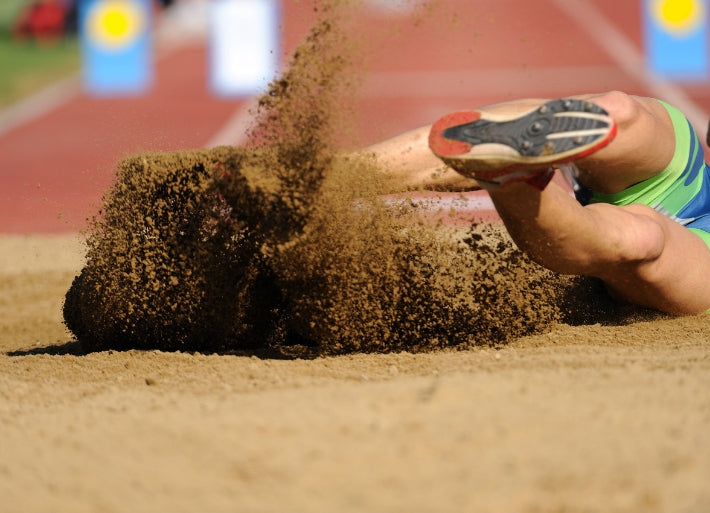
How Do You Train for Long Jump?
BY RUBY JERGES
As we say goodbye to the indoor season, setting ourselves up correctly for the outdoor season is vital to ensuring we are both physically and mentally prepared for what is to come.
In this article, I will break down some of my top recommendations for preparing for the coming season, including goal setting, managing logistics and organization for competitions. I will also provide insight into how you can prepare for the transition to the outdoor season!
HOW DO YOU GET GOOD AT LONG JUMP?

QUALITY VS QUANTITY
Two words I consider vital when approaching each training session are ‘quality’ and ‘quantity.’ Understanding the difference between the two ensures I can dictate how I approach my training sessions, depending on the proximity to my next competition.
QUALITY
For example, let’s pretend that it is a Wednesday track session and that I have a competition on the weekend. In this scenario, I will want to ensure that I am set up as well as possible for my competition. Therefore I need to minimize the chances of fatigue or DOMS from training.
Subsequently, I will focus on perfecting any technical areas I need to consolidate before the upcoming competition. This example emphasizes how the quality of training needs to be my priority rather than quantity.
QUANTITY
Alternatively, suppose it is early March. The indoor season has just ended, and the outdoor season is a few months away. This would be an excellent time to increase the intensity and quantity of exercise to build speed and strength (as well as continue with the technical aspects, of course!).
Although the quality and quantity of training are relevant all year round, I believe that it’s always a good idea to be able to alter and balance between the two, dependent on the time of the year and the proximity to the coming season and competitions. You can do this in collaboration with your coach and their plans for training!
IS THERE A TECHNIQUE TO LONG JUMP?

MENTAL PREPARATION
GOAL SETTING
During my A levels, I learnt a lot about how goal setting can be used, not just technically but also to refine my mental skills. Key to this was setting realistic aims and keeping my mind on a target without it being too stressful.
SMART GOAL SETTING
A widespread method of goal setting used in sports science is creating SMART goals and objectives. Using this encourages individuals to set specific, Measurable, Agreed (with coach), Realistic and time-bound goals. Personally, I find it beneficial to set individual SMART goals for my competition performances and outcomes.
PERFORMANCE GOAL SETTING
Setting a goal targeting improvement of my performance allows me to focus on the technical aspects of my sport, for example, my running technique and how I attack the board. I can break down the more minor details that need to be improved in my technique which helps to keep me on target. Focusing on the technical aspects helps me understand what is required to execute the jump and subsequently achieve my outcome goal, which is more likely to be positive as a result.
OUTCOME GOAL SETTING
If I set a goal for the outcome of a competition, I would likely base it on the distances of how far I want to jump and where I am aiming to position. This is more about the outcome of the performance rather than the steps it takes for me to reach the outcome.
I believe using these different types of goals is helpful as it helps to have a vision of how best to achieve where I want to be at my end goal.
It sounds obvious, but don’t set your sights too high. I’ve done that in the past, and it can be a weight on your shoulders that you just don’t need! By setting your goals too high, you become too fixated on the outcome and, as a result, don’t focus on the areas to improve. Keeping your goals achievable will help you maintain motivation and engagement while pushing you as an athlete to get that little bit further and challenge yourself to achieve your very best.
WHAT AFFECTS PERFORMANCE IN LONG JUMP?

CONVERSATIONS WITH SUPPORT TEAM
Maintaining regular communication between yourself and your support team members ensures that everyone is on the same page with organization and preparation all year round. When I talk about the support team, this is not only your coach but also parents, teachers, nutritionists, family, friends etc. (dependent on who you may have around you).
Competing takes a lot more than just turning up on the day. Athletes must organize transport, timings, food, kit, and many other elements. To manage the stress more effectively, it is a good idea for you to share this responsibility, even if that means just discussing it verbally with those around you to relieve some of the pressure.
It may seem trivial before the event, but details such as planning parking or travel on the day of the competition could significantly impact how you perform on the day.
KIT AND EQUIPMENT PREPARATION

While getting new kit and equipment can be one of the most exciting parts of athletics for some people, they must be regularly checked in terms of their sizes and condition.
In all athletics disciplines, specialized shoes can be purchased. Shoes are one example of an item of kit that needs to be checked regularly for size, fit and wear and tear. Don’t leave it until the day before the competition to find out you are missing spikes or that they are the wrong size. Worse still is finding out you’ve grown since you last competed and they don’t fit any more! Give yourself time and make sure you check all your kit well before competition time.
For the long jump, although not always necessary in all types of training sessions, spikes can be worn all year round. The more wear they get, the more often they need to be replaced. It is important to regularly replace the spikes in shoes as they will become blunt, and these minute details can impact your performance on the day.

ADAPTING TO BAD WEATHER IN ATHLETICS
Don’t forget the weather, either! When planning your kit for the season, think about how much the weather can change. I’ve been jumping in pouring rain one day and blistering sunshine the next, so make sure you are prepared for all eventualities.
This preparation isn’t just limited to what you wear. For example, measuring tape can reliably mark out a long jump run-up during indoor competitions or sunny conditions. However, the tape will unlikely stay stuck to the ground in wet and rainy conditions. So, think ahead, check the weather, and ensure you have considered all possible scenarios.

TRAINING/ROUTINE/LIFESTYLE
Having regular day-to-day routines and planning are two things that give me great satisfaction (when everything goes to plan!).
Knowing what you are supposed to be doing and when (whether that’s training/education/rest, or anything else) allows you to prepare in advance for significant events. This also makes it easier to make adjustments or additions in case of any last-minute alterations. So, create a routine around your training and leave space for the other things that are important in your life. Athletics can be all-consuming, but balance is important – so do try to give yourself space and time to do you!

WHAT SHOULD A LONG JUMPER EAT?
Additionally, when considering everyday routines and training, attention always needs to be made to food and what and when you are eating because food is what helps fuel you! I have learnt recently that when I am anticipating a busy day, it takes no time to make extra food the night before and save a bit for lunch the next day as food prep. This saves time and ensures that your day’s productivity doesn’t decrease due to hunger or lack of energy, whether in training or regular daily activities.

WHAT ARE THE MAIN TEACHING POINTS OF LONG JUMP?
Organization is a reoccurring recommendation that I suggest taking away from this article that can be applicable to all aspects of preparation. This can be related to goal setting, communication, planning, kit, etc. As long as you remain in control in as much as possible of what you are doing, positive outcomes will occur.
Thank you for taking the time to read my blog, and I hope this can be of some value to you as we progress further into the 2023 competition season!
ABOUT RUBY JERGES

Ruby is primarily a long jumper, but is also known as a sprinter!
She started doing gymnastics for a little while at just five years old, but then realised in secondary school that athletics was what she wanted to pursue.
Ruby loves to inspire young girls in getting involved with athletics, and is keen to start writing for us!
She competes for Crawley AC, as well as for Loughborough University.
Instagram: @ruby.jerges


Leave a comment